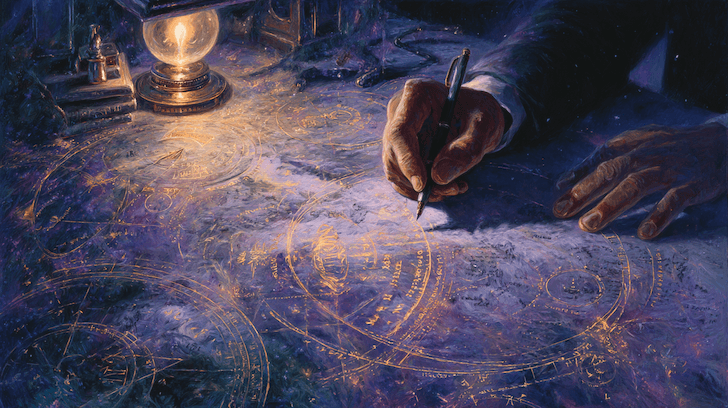Rectifying Birth Times

Knowing your exact birth time lets you calculate the Ascendant and house cusps precisely. That unlocks where planets fall by house (life areas) and how transits hit your angles (Ascendant, Descendant, Midheaven, IC). Without a reliable time, you still have a lot to work with—but you’ll miss the cleanest timing and placement details.
Houses turn roughly every two hours. A difference of even 20–30 minutes can move a planet into a different house or shift the rising sign. Exact time = clean houses and angles.
What You Can Read Without Exact Time
You still have a solid foundation even with an unknown or approximate time.
- Planetary signs: Sun, Moon, and planets by sign are valid for the whole day (unless the Moon changes signs that day—check).
- Aspects between planets: Major aspects (conjunction, opposition, square, trine, sextile) are largely stable all day.
- Element and modality mix: Fire/Earth/Air/Water and Cardinal/Fixed/Mutable counts still help describe your baseline style.
- Transits to planets: You can track when sky planets aspect your natal planets by sign and degree (angles will be approximate).
How Precise Do You Need To Be
More precision buys you better house and timing accuracy. Here’s a practical reference:
| Precision | What You Can Trust | What To Treat With Caution |
|---|---|---|
| Unknown day or location | Planetary signs for outer planets | Moon sign, any houses, angles, all timing |
| Date known, time unknown | All planetary signs, inter-planet aspects | Moon sign if it changes; all houses and angles |
| ±6 hours | Likely Moon sign, rough rising-sign candidates | Exact Ascendant, house placements, transit timing to angles |
| ±2 hours | Narrow rising-sign choices; some house placements | Borderline house cusps; exact angular hits |
| ±30 minutes | Ascendant, houses mostly reliable | Planets within ~5° of a cusp; minute-precision techniques |
| Birth certificate time | Full houses, angles, timing | Daylight-saving or recording errors—verify once |
Best Ways To Find Your Time
Start with official records, then expand.
| Source | Where To Look | Notes |
|---|---|---|
| Birth certificate | Vital records office, hospital archives | Ask for the long-form certificate; some regions omit time on short forms |
| Hospital or midwife log | Hospital medical records, midwifery practice | Requires ID and consent; may take weeks |
| Family records | Baby books, letters, emails, texts, photos | Look for timestamps, clock photos, or “around” notes |
| Government filings | Immigration, adoption, church records | Sometimes include recorded time |
If you can’t secure documentation, you can still rectify—an informed, careful process of narrowing the time by matching your life events to the chart.
Rectification Overview
Rectification compares multiple candidate times with real events and traits. Keep orbs tight, work in windows, and test for repeatable hits.
- Set a window. Collect family clues: “near sunrise,” “around noon,” “after dinner.” Convert those to a 2–3 hour window.
- Cast several charts in the window. Try every 15–30 minutes. Note changing Ascendant signs and house shifts.
- Check the rising sign fit. Element, modality, and ruler by house should match your outward style and body language.
- Test life events against angles. Big moves, job changes, marriages, breakups, births, losses, injuries—do transits/progressions hit the AC/DC/MC/IC at those dates when the time is set a certain way?
- Use the progressed Moon. It changes signs ~every 2.5 years and crosses angles noticeably.
- Do those dates line up with moves, job pivots, shifts in mood or focus?
- Look for repetition. The right time will fit multiple events cleanly (within tight orbs), not just one story.
Techniques That Help
- Transits to angles: Keep orbs tight (≤2–3°). Outer-planet hits (Saturn–Pluto) to AC/DC/MC/IC often bracket chapters.
- Secondary progressions: Progressed Moon to angles or Sun/Moon aspects correlate with mood and role shifts.
- Solar returns: The solar return angles for the correct natal time tend to describe public themes of the year more clearly.
- Lunar returns: Monthly charts can highlight the house focus; compare a few months around known events.
Common Pitfalls
Rectification is easy to get wrong if you force a narrative. Avoid these traps.
- Confirmation bias: Don’t cherry-pick a single event. The right time fits many events, not just one.
- Wide orbs: Oversized orbs make any time fit. Stay tight: 2–3° for angles, 1–2° for progressions.
- Using personality alone: Stereotyping rising signs is unreliable. Prioritize timing evidence.
- Time-zone and DST errors: Verify local time rules for the date and place; location coordinates matter.
- Ignoring cusps: Planets near house lines may switch houses across candidate times—track both versions.
Sensible Warnings and Encouragement
- Be honest about certainty. If you only narrow to a 90-minute window, say so. You can still read the chart—just qualify house calls.
- Prefer evidence over vibe. A time that matches multiple dated events beats a time that only “feels right.”
- Iterate as you learn. Keep a log of dates and re-test the time when new life events occur—good rectification gets tighter over time.
- It’s doable. With a reasonable window, clear life events, and disciplined orbs, most people can get within 10–20 minutes.
You don’t need a perfect timestamp to learn from your chart. Start with what’s certain (planetary signs and aspects), narrow the window with evidence, and keep refining. The goal isn’t guesswork—it’s a time that consistently predicts your life’s turns.
How to Read a Birth Chart

How to Read Transits

Get Your Birth Chart
Calculate your complete astrological chart with precise astronomical data based on your birth time and location
Generate Chart